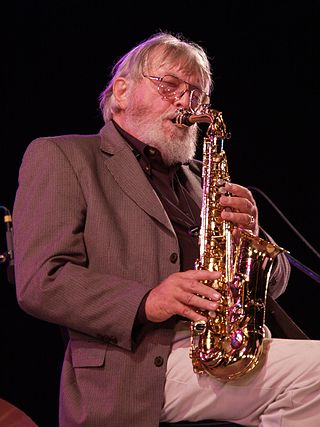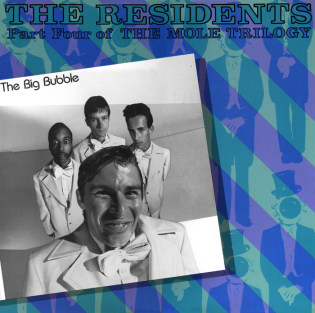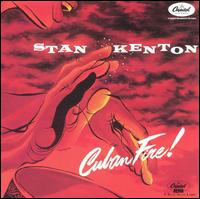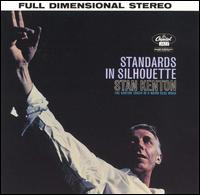
The Residents are an American art collective and art rock band best known for their avant-garde music and multimedia works. Since their first official release, Meet the Residents (1974), they have released over 60 albums, numerous music videos and short films, three CD-ROM projects, and ten DVDs over the course of over half a century. They have undertaken seven major world tours and scored multiple films. Pioneers in exploring the potential of CD-ROM and similar technologies, the Residents have won several awards for their multimedia projects. They founded Ralph Records, a record label focusing on avant-garde music, in 1972.

Walter Maynard Ferguson CM was a Canadian jazz trumpeter and bandleader. He came to prominence in Stan Kenton's orchestra before forming his own big band in 1957. He was noted for his bands, which often served as stepping stones for up-and-coming talent, his versatility on several instruments, and his ability to play in a high register.

Clifford Everett "Bud" Shank Jr. was an American alto saxophonist and flautist. He rose to prominence in the early 1950s playing lead alto and flute in Stan Kenton's Innovations in Modern Music Orchestra and throughout the decade worked in various small jazz combos. He spent the 1960s as a first-call studio musician in Hollywood. In the 1970s and 1980s, he performed regularly with the L. A. Four. Shank ultimately abandoned the flute to focus exclusively on playing jazz on the alto saxophone. He also recorded on tenor and baritone sax. His most famous recording is probably the version of "Harlem Nocturne" used as the theme song in Mickey Spillane's Mike Hammer. He is also well known for the alto flute solo on the song "California Dreamin'" recorded by The Mamas & the Papas in 1965.

Gerald Joseph Mulligan, also known as Jeru, was an American jazz saxophonist, clarinetist, composer and arranger. Though primarily known as one of the leading jazz baritone saxophonists—playing the instrument with a light and airy tone in the era of cool jazz—Mulligan was also a significant arranger working with Claude Thornhill, Miles Davis, Stan Kenton, and others. His piano-less quartet of the early 1950s with trumpeter Chet Baker is still regarded as one of the best cool jazz ensembles. Mulligan was also a skilled pianist and played several other reed instruments. Several of his compositions including "Walkin' Shoes" and "Five Brothers", have become standards.

Andrew Carthy, known professionally as Mr. Scruff, is an English record producer and DJ. He lives in Stretford, Greater Manchester and studied fine art at the Psalter Lane campus of Sheffield Hallam University. Before he could make a living from his music alone, he worked as a shelf stocker in the Hazel Grove branch of Kwik Save.

Stanley Newcomb Kenton was an American popular music and jazz artist. As a pianist, composer, arranger and band leader, he led an innovative and influential jazz orchestra for almost four decades. Though Kenton had several pop hits from the early 1940s into the 1960s, his music was always forward-looking. Kenton was also a pioneer in the field of jazz education, creating the Stan Kenton Jazz Camp in 1959 at Indiana University.

Mark of the Mole is the eighth studio album by American art rock group The Residents, released in 1981 on Ralph Records. The first in what was intended to be a "trilogy" with a narrative centred on a conflict between two rival peoples, the Moles and the Chubs.

Intermission: Extraneous Music from the Residents' Mole Show is an EP by The Residents, released in 1982. It features music from the opening, closing, and intermission portions of the Mole Show. It was the first in a line of albums that would bear the warning that it was not part three of the Mole Trilogy.

The Big Bubble is an album released by American art rock group The Residents in 1985. The album is presented as the debut of fictional garage rock band "the Big Bubble", composed of four "Cross" band members – "Cross" being the resulting mixture between the Mole Trilogy's two contrasting factions, the Moles and the Chubs.
Afro-Cuban jazz is the earliest form of Latin jazz. It mixes Afro-Cuban clave-based rhythms with jazz harmonies and techniques of improvisation. Afro-Cuban music has deep roots in African ritual and rhythm. The genre emerged in the early 1940s with the Cuban musicians Mario Bauzá and Frank Grillo "Machito" in the band Machito and his Afro-Cubans in New York City. In 1947, the collaborations of bebop trumpeter Dizzy Gillespie and percussionist Chano Pozo brought Afro-Cuban rhythms and instruments, such as the tumbadora and the bongo, into the East Coast jazz scene. Early combinations of jazz with Cuban music, such as "Manteca" and "Mangó Mangüé", were commonly referred to as "Cubop" for Cuban bebop.

Machito was a Latin jazz musician who helped refine Afro-Cuban jazz and create both Cubop and salsa music. He was raised in Havana with the singer Graciela, his foster sister.

June Christy was an American singer, known for her work in the cool jazz genre and for her silky smooth vocals. Her success as a singer began with The Stan Kenton Orchestra. She pursued a solo career from 1954 and is best known for her debut album Something Cool. After her death, she was hailed as "one of the finest and most neglected singers of her time."

Gabriel Ruiz Hiroshi Baltazar Jr. was an American jazz alto saxophonist and woodwind doubler.

Willis Leonard Holman was an American composer, arranger, conductor, saxophonist, and songwriter working in jazz and traditional pop. His career spanned over seven decades, starting with the Charlie Barnet orchestra in 1950.

Something Cool is the debut solo album by June Christy, released on Capitol Records first as a 10-inch LP of seven selections in August of 1954, and then as a 12-inch LP of eleven selections the following August, both times in monophonic sound. The original seven selections for the 1954 release were recorded over seven sessions from August of 1953 through March of 1954, with the additional four for the 1955 issue from four additional sessions in December of 1954 as well as May and June of 1955, with arrangements for all sessions written and conducted by Pete Rugolo. Her saxophonist husband, Bob Cooper, also played on many of these sessions. In April of 1960, Christy and Rugolo re-recorded all 11 selections in stereophonic sound, so that a stereo version of Something Cool could be issued. For many years, this re-recorded version of the album was the only one commercially available.

Cuban Fire! is an album by Stan Kenton and his orchestra released in 1956 by Capitol Records. This was Stan Kenton's big band's first full-length recording of Afro-Cuban-styled music. The LP charted for four weeks in Billboard starting on September 15, 1956, peaking at #17. The concept of the original 1956 recording centers on the Cuban Fire! suite Kenton had commissioned from composer Johnny Richards. The 1991 CD re-issue is augmented with one extra track from the 1956 sessions and five cuts recorded four years later by the first of Kenton's mellophonium orchestras.

Standards in Silhouette is an album recorded in September 1959 by Stan Kenton and his orchestra. The entire set of arrangements for the LP were written by Bill Mathieu. This recording stands alone in approach and style; Kenton himself only plays on "Django" and every standard is done at a slow, ballad tempo with very sparse, effusive writing.

City of Glass, an album originally issued as a 10" LP by Stan Kenton, consists entirely of the music of Bob Graettinger. The original album has been reconstituted in different LP re-issues, and the entire set of Kenton/Graettinger Capitol Records sessions is on the digital CD City of Glass.

Adventures in Jazz is an album by the Stan Kenton Orchestra, recorded in late 1961 but not released until about a year later in November 1962. The album won a Grammy Award in the category for Best Jazz Performance – Large Group (Instrumental) category in 1963. This would be Kenton's second Grammy honor in as many years, the first being Kenton's West Side Story winning the Best Large Jazz Ensemble Album in 1962. Adventures In Jazz was also nominated for Best Engineered recording for the 1963 Grammys. The 1999 CD re-issue of Adventures In Jazz is augmented with two alternate takes from the original recording sessions and one track from Kenton's release Sophisticated Approach.

The Ghost of Hope is the 44th studio album by American art rock band the Residents. It is based around historical train wrecks.


















